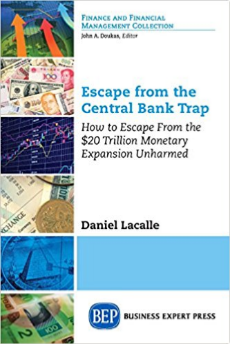Fast forward a couple of years, and the voices railing against quantitative easing are even stronger than those that initially clamored for it. While the theory behind quantitative easing suggests it should ultimately boost demand and investment and thereby the real economy, in reality the benefits in the Euro area seem to have been muted. At the same time, perverse situations generated by the ECB’s bond-buying program have proliferated. The average yield of euro-denominated junk bonds, i.e. the riskiest, non-investment-grade corporate bonds, recently dropped below 3% to come remarkably close to the yields on U.S. Treasuries, which are much more liquid and considered the safest investment.
 In his latest book Escape from the Central Bank Trap, Daniel Lacalle joins the anti-QE camp with a convincing tirade against so-called “unconventional” monetary policy, which he suggests has become far too common and conventional. He puts experiences of quantitative easing in the United States, Japan and Europe under the spotlight in order to denounce modern monetary theory as a short-term trap that fails to resolve structural imbalances, and argue instead in favor of supply-side policies.
In his latest book Escape from the Central Bank Trap, Daniel Lacalle joins the anti-QE camp with a convincing tirade against so-called “unconventional” monetary policy, which he suggests has become far too common and conventional. He puts experiences of quantitative easing in the United States, Japan and Europe under the spotlight in order to denounce modern monetary theory as a short-term trap that fails to resolve structural imbalances, and argue instead in favor of supply-side policies.
In the European case, Lacalle argues, “the central bank did not function as a transmission mechanism to improve the real economy, but as a perpetuator and instigator of yet another asset bubble.” In other words, low-interest-rate risk has simply moved from house prices to bonds. ECB president Mario Draghi’s warnings to governments not to forget that QE is supposed to be a temporary measure, and that structural reforms remain as necessary as ever, have largely gone unheeded. And so the new bubble is being perpetuated.
Lacalle’s focus on structural reforms and supply-side measures puts him at risk of attracting the wrath of left-wing and anti-capitalist commentators and of being dismissed by them as a libertarian. But he anticipates and attempts to counter such criticism by arguing that quantitative easing has actually contributed to the rise in inequality that such commentators are concerned about. QE programs, he suggests, “disproportionately benefit those who have access to widespread credit and whose wealth is in financial assets,” while hitting ordinary citizens with small savings in cash, which becomes devalued.
“Even if the reader disagrees,” he says, “the question is simple. How do we get out of expansionary policies without another financial crisis that hurts, again, households and taxpayers the most?”
Lacalle does not mince his words in warning of the risks of prolonged QE. “If EU countries get used to ultralow rates,” he suggests, “the risk of multibillion nominal and real losses in bond portfolios and pension funds is enormous, because the tiniest tilt in inflation will make the house of cards collapse.” In the present scenario, “if interest rates raised a stunted one percent in the European Union, it would lead to massive budget cuts to maintain current deficits.”
The irony here, if we compare Lacalle’s words with European governments’ initial reasons for wanting QE, cannot go unnoticed. Since QE slashes borrowing costs, desperate governments had pinned their hopes on it reducing—at least marginally, and temporarily—the pressure for ever stricter austerity measures.
While most of the jury now seems to be out on quantitative easing, an alternative remains elusive. In addition to structural reforms to promote lower government spending and higher efficiency, Lacalle recommends tax cuts to let households and SMEs thrive. In this regard, he reminds us that in Europe, it was the Netherlands and the UK which emerged from recession earlier. They were the countries which reduced taxes rather than boosting government spending during the initial period of stimulus across the EU at the height of the financial crisis, prior to the shift to austerity.
Convincing citizens of all this and thereby making it politically viable is however entirely another matter, as Lacalle himself acknowledges. Tax cuts may be welcomed if the public perceives them as benefitting the ordinary citizen rather than just wealthy high earners, but on their own they cannot suffice. Meanwhile, citizens who have already suffered enough from austerity are understandably not about to change their tune and embrace the need for structural reforms, which often have an overwhelmingly harsh short-term impact before the longer-term benefits start to become apparent. The central bank trap is clearly anything but an easy one to get out of.
Author: Caroline Gray, PhD, Senior Economics Editor
 Daniel Lacalle is a fund manager who holds a PhD in Economics and has a CIIA financial analyst title. He is author of “Life In The Financial Markets” and “The Energy World Is Flat” (Wiley) as well as “Escape from the Central Bank Trap” (BEP). He has been ranked as one of the Top 20 Economists in the World by Richtopia and has over 24 years of experience in the energy and finance sectors.
Daniel Lacalle is a fund manager who holds a PhD in Economics and has a CIIA financial analyst title. He is author of “Life In The Financial Markets” and “The Energy World Is Flat” (Wiley) as well as “Escape from the Central Bank Trap” (BEP). He has been ranked as one of the Top 20 Economists in the World by Richtopia and has over 24 years of experience in the energy and finance sectors.
Follow Daniel on Twitter. Visit Daniel’s website here.
Sample Report
5-year economic forecasts on 30+ economic indicators for 127 countries & 33 commodities.